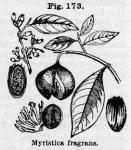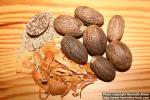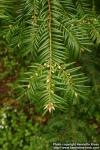
 Related entries: Macis (U. S. P.)—Mace - Oleum Myristicae (U. S. P.)—Oil of Nutmeg - Oleum Myristicae Expressum.—Expressed Oil of Nutmeg
Related entries: Macis (U. S. P.)—Mace - Oleum Myristicae (U. S. P.)—Oil of Nutmeg - Oleum Myristicae Expressum.—Expressed Oil of Nutmeg
"The seeds of Myristica fragrans, Houttuyn," "deprived of its testa"—(U. S. P.).
Nat. Ord.—Myristicaceae.
COMMON NAME: Nutmeg (Nux moschata).
ILLUSTRATION: Bentley and Trimen, Med. Plants, 218.
Botanical Source.—This is a tree from 20 to 25 feet high, having a grayish-brown, somewhat smooth bark, abounding in a yellow juice; the branches are spreading, in whorls. The leaves are alternate on petioles from ½ to ¾ of an inch long, plane above, or oblong, approaching to elliptical, subbifarious, glabrous, rather obtuse at the base, acuminate, quite entire, aromatic, dark-green and somewhat glossy above, paler beneath, and from 3 to 6 inches long. The flowers are dioecious, small, in axillary, subumbellate racemes, sometimes forked, or compound. The peduncles and pedicels are glabrous, the latter having a quickly deciduous, ovate bract at its summit, often pressed close to the flower. Male flowers, 3 to 5, or more, on a peduncle. Calyx urceolate, thick, fleshy, clothed with a very indistinct, reddish pubescence, dingy pale-yellow, cut into 3 erect, or erecto-patent teeth. The filaments are incorporated into a thickened, whitish cylinder, about as long as the calyx, the upper half covered by about 10 linear-oblong, 2-celled anthers, free at their base, opening longitudinally. The female flowers are scarcely different from the male, except that the pedicel is very frequently solitary. Pistils solitary, shorter than the calyx, broadly-ovate, a little tapering upward into a short Style, bearing a 2-lobed, persistent stigma. The fruit is a fleshy pericarp, nearly spherical, of the size, and somewhat of the shape, of a small pear; flesh astringent, yellowish, almost white within, 4 or 5 lines thick, opening into 2, nearly equal, longitudinal valves. The arillus (mace) is thick, between horny and fleshy, much laciniated, folded and anastomosing toward the extremity, almost enveloping the nut, and so tightly as to form inequalities on its surface; when fresh, brilliant scarlet; when dry, much more horny, of a yellowish-brown color, and very brittle. The nut is oval or broadly-ovate, with a hard, rugged, dark-brown, glossy shell, pale, smooth within, about half a line thick. The seed, or nutmeg, is oval, pale-brown, quite smooth when fresh, but soon becomes shriveled, with irregular, vertical lines or furrows on its surface. Its substance or albumen is firm, fleshy, whitish, being traversed by veins of a red-brown color, abounding in oil. Near the base of the albumen, imbedded in a cavity in its substance, is the embryo, which is small, fleshy, yellowish-white, rounded below, and where is found the hemispherical radicle; cotyledons of 2, large, somewhat foliaceous, plicate lobes, in the center of which is seen the plumule (L.).
History and Description.—This tree has received several botanical names, as M. officinalis, Linné, M. moschata, Thunberg, M. aromatica, Lamarck, and M. fragrans, Houttuyn; this last is the one now generally adopted by botanists. The nutmeg tree is indigenous to the Molucca Isles, and is raised in Sumatra, French Guiana, the Mauritius, and various West Indian Islands. The nutmeg tree is propagated by planting the uninjured seed; when it has attained the age of about 9 years, it commences to blossom, and continues to yield fruit for about three-quarters of a century, requiring hardly any attention from its cultivators. The seeds are frequently spread in the Banda Isles by certain species of pigeons, which thus contribute to the propagation of the tree. In the eighteenth century this was the cause of much disaster to the natives of these islands in their dealings with the Dutch East Indian Company who endeavored to limit and monopolize the plantation of the nutmeg tree, by prohibiting its being planted on certain isles (A. Tschirch, Indische Heil- und Nutzpflanzen, Berlin, 1892, p. 104). In the Banda Isles there are three harvests annually, the principal one in July or August, in November, and in March or April. The ripe fruit is gathered by means of a barb attached to a long stick; the mace or arillus separated from the nut, and both separately cured (P.). The kernel of the fruit, or nutmeg, and the arillus of the nut, or mace (see Macis), are the official parts; they are imported from the East Indies, from Europe, and a small portion from the West Indies.
The nutmegs, previous to exportation, undergo a process of curing to preserve them, and protect them from the attacks of insects; the nuts are exposed to the sun for 4 or 6 days, and afterward smoke-dried for several weeks at about 60° C. (140° F.); when thoroughly dried, the kernel rattles in the shell, which is then cracked with a wooden mallet, and the perfect nuts selected; these are then covered with dry lime or steeped for a time in a thick mixture of lime and water; the former is considered the preferable plan. Nutmegs are officially described as follows: "Oval or roundish-ovate, about 25 Min. (1 inch) long, light-brown, reticulately furrowed, with a circular sear on the broad end; internally pale-brownish, with dark orange-brown veins, and of a fatty lustre; odor strongly aromatic; taste aromatic, warm, and somewhat bitter"—(U. S. P.). From the interior veins mentioned, an oil may be easily expressed with the point of a warm knife. The virtues of nutmegs are extracted by alcohol or ether. The small, round, heavy nutmeg is esteemed superior to those which are larger, longer, lighter, less marbled, and not so oleaginous. It produces a grayish-brown, somewhat fatty powder. Singapore and Penang nutmegs are unlimed; those from the Dutch colonies are limed. (For botanical and anatomical studies of various species of Myristica, see A. Tschirch [Jahresb. der Pharm., 1885, p. 98, and 1887, p. 108, and Archiv der Pharm., 1895, p. 443]; also J. Moeller [Pharm. Centralhalle, 1880, pp. 453, 465 and 473], and W. Busse [Jahresb. der Pharm., 1895, p. 113].) An exhaustive and classical monograph, on the history, botany, commercial aspect, etc., of nutmeg, was written quite recently by O. Warburg (1897).
Chemical Composition.—Nutmegs contain 8 to 10 per cent of volatile oil (see Oleum Myristicae), 30 to 40 per cent of fatty oil (see Oleum Myristicae Expressum), from 9 to 13 per cent of water, and about 5 per cent of ash; furthermore, nitrogenous matter, starch, gum, woody fiber, etc. The fatty oil of nutmeg contains as the characteristic constituent, about 12 per cent of myristin, the glycerin ester of myristic acid (C14H28O2), discovered by Playfair, in 1841. Stearic and oleic acids are likewise present in the fatty oil.
Action, Medical Uses, and Dosage.—Both nutmeg and mace possess aromatic stimulating properties, and are occasionally used to remove flatulency, correct the nausea arising from other drugs, and to allay nausea and vomiting. It may be used in gastrodynia and atonic diarrhoea. The nutmeg forms a very agreeable addition to various drinks for convalescents, as well as to some articles of diet; it is generally grated over them, or mixed with them. Applied locally, grated nutmeg, mixed with lard, has been found an excellent application in piles, and the nutmeg roasted is used internally in some parts of the country, as a domestic remedy for leucorrhoea. I have known the following preparation to cure several cases of intermittent fever, and have been assured of its almost universal success in this disease. It is also recommended for the cure of other forms of fever. Char a nutmeg by holding it to the flame, and permitting it to burn by itself without disturbance; when charred, pulverize it, combine it with an equal quantity of burnt alum, and divide the mixture into three powders. On the commencement of the chill, give a powder—if this does not break it, give the second powder on the approach of the next chill, and if not cured, the third powder must be given as the succeeding chill comes on. Usually the first powder effects a cure, and it is seldom that the three powders are required. The bowels should be acted upon by a purgative previous to the administration of the powders. It is certainly deserving attention, though I do not pretend to account for its action (J. King). Nutmeg occasionally controls passive uterine hemorrhage. The powder, dusted upon a larded cloth, is effectual as an application to the chest in pneumonic complaints and colds, and to the bowels in cholera infantum, and over the stomach to allay vomiting. Dose of nutmeg or mace, from 5 to 20 grains. Larger doses possess decided narcotic qualities, and in doses of 2 or 3 drachms, dangerous symptoms have been produced. Death followed the eating of two nutmegs by a boy of 4 years. The symptoms produced in various cases of nutmeg poisoning vary. The chief symptoms, however, are headache, coldness and collapse, drowsiness, indisposition to muscular movement, and increased diuresis. In fatal cases the urine as been suppressed (see case of Myristica poisoning, Ec. Med. Jour., 1891, p. 125; also Amer. Jour. Pharm., 1885, p. 23).
Ɣ Related Species and False Nutmegs.—Myristica argentea, Warburg, grows in New Guinea; its leaves are silvery below, hence the name. The nutmeg is longer and narrower than that of M. fragrans, after which it ranks next in commercial importance. Instead of this species M. fatua, Houttuyn, growing in the Molucca Islands, has for a long time been erroneously believed to yield the long nutmeg of commerce. The seed of M. fatua (Male nutmeg, Mannetjes-nooten) soon loses its already weak aroma.
M. madagascariensis, Lamarck, growing in Madagascar, and cultivated in the French island of Bourbon, is probably identical, according to Warburg (Ber. d. Deutsch Pharm. Ges., 1892, p. 211), with M. fragrans.
M. officinalis, Martius, growing in Brazil, yields the solid Bicuyba oil of the Brazilians. The seed is but faintly aromatic, and yields 72 per cent of oil (see analysis by A. Stutzer, Jahresb. der Pharm., 1887, p. 108).
M. bicuhyba, Schott, growing in Brazil, produces a seed of an agreeable, cacao-like odor. H. Nördlinger (Amer. Jour. Pharm., 1886, p. 88) found the dried kernels to yield 73.7 per cent of an aromatic fat, chiefly the glycerides of myristic and oleic acids with free myristic acid.
M. surinamensis, Roland. Reimer and Will found in the seeds 73 per cent of a slightly aromatic fat, melting at 45° C. (113° F.), and consisting of myristin and 6.5 per cent of myristic acid (Amer. Jour. Pharm., 1886, p. 88).
M. malabarica, Lamarck, is believed to yield Bombay mace (see Macis). Prof. Schaer (1896) found in the inspissated extract of the bark a new kino (see Kino).
CALABASH NUTMEG, or JAMAICA NUTMEG, is the product of Monodora Myristica; PLUME, or NEW HOLLAND NUTMEG, from Atherosperma moschata; and CLOVE NUTMEG, from Agathophyllum aromaticum. (For species yielding oils, see also Oleum Myristicae Expressum.)
 CALIFORNIA NUTMEG.—The seed of a California conifer, the Torreya californica, Torrey (Torreya Myristica, Hooker). It has a terebinthinate taste, is oblong, its testa smooth, brown and thin, and the seed upon cross-section is marbled.
CALIFORNIA NUTMEG.—The seed of a California conifer, the Torreya californica, Torrey (Torreya Myristica, Hooker). It has a terebinthinate taste, is oblong, its testa smooth, brown and thin, and the seed upon cross-section is marbled.

